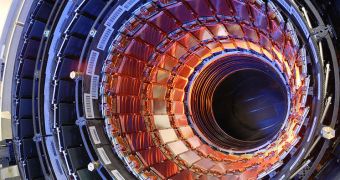Physicists operating one of the three main particle detectors on the Large Hadron Collider's (LHC) 27-kilometer tunnels announce that they were able to observe a state of matter that they believe permeated the Universe shortly after the Big Bang inflated everything into being.
After the quantum fluctuation event that led to the rapid expansion of the Cosmos, the matter that created everything we see in space today was confined within a very small space.
In the first fractions of a second after the Big Bang, that volume expanded millions of times over, and the matter contained within changed states repeatedly. One of the main goal of the LHC is to recreate those conditions.
One of them is represented by a state of matter called quark-gluon plasma (QGP), which is believed to have permeated the Universe several millionths of a second after its birth. This state of matter is extremely hot and dense.
Physics experts operating the Compact Muon Solenoid (CMS) particle detector on the LHC say that they have discovered indications that collisions conducted at the CERN facility produced this elusive state of matter.
The European Organization for Nuclear Research (CERN) operates the LHC underneath the city of Geneva, at the French-Swiss border. Since being turned on, the accelerator has carried out collisions using protons and heavy lead ion beams.
QGP is a form of plasma in which a fluid gas of free quarks and gluons can exist. Generally, quarks are held together in pairs, or in groups of three, by gluons.
These particles are called gluons because their role is to literally glue together quarks. They are elementary bosonic particles, meaning they are force-carriers. Gluons have a spin of 1, Daily Galaxy reports.
Under extreme conditions – high temperatures and pressures – gluons can separate from their quarks, allowing for QGP to form. These conditions can only be obtained when replicating the Big Bang.
The first signs of this type of plasma were obtained at the Relativistic Heavy Ion Collider (RHIC) instrument of the Brookhaven National Laboratory (BNL), in Upton, New York. The BNL is operated by the US Department of Energy (DOE).
“What is happening may be fully understood in the next few months or year,” CMS spokesman Guido Tonelli explains. The collisions the LHC is capable of producing are dubbed “First Physics,” because they recreate the conditions that existing within the first billionth of a second after the Big Ban.

 14 DAY TRIAL //
14 DAY TRIAL //